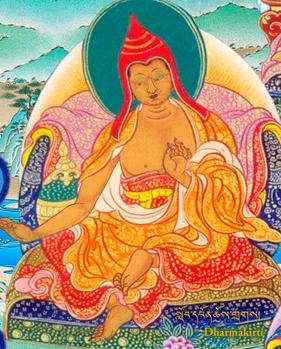Sautrantika: Difference between revisions
Jump to navigation
Jump to search
mNo edit summary |
No edit summary |
||
| (4 intermediate revisions by the same user not shown) | |||
| Line 1: | Line 1: | ||
[[Image:Dharmakirti.JPG|frame|[[Dharmakirti]]]] | [[Image:Dharmakirti.JPG|frame|[[Dharmakirti]]]] | ||
'''Sautrantika''' (Skt. ''Sautrāntika''; Tib. [[མདོ་སྡེ་པ་]] ''Dodépa'' | '''Sautrantika''' (Skt. ''Sautrāntika''; Tib. [[མདོ་སྡེ་པ་]], ''Dodépa'', [[Wyl.]] ''mdo sde pa'') — a [[shravakayana]] school of early Buddhism, which formed out of the larger [[Sarvastivadin]] school. | ||
Sautrantika means ‘Follower of the Sutras’, and the members of this school are so-called because they do not accept the [[Abhidharma]] as a definitive teaching of the [[Buddha]]. | |||
==Subschools== | |||
There are two kinds of Sautrantikas or ‘Sutra Followers’: | There are two kinds of Sautrantikas or ‘Sutra Followers’: | ||
*the '''Sautrantikas Following Scripture''' whose description of the [[two truths]] accords with that of the [[Vaibhashika]]s; and | *the '''Sautrantikas Following Scripture''' whose description of the [[two truths]] accords with that of the [[Vaibhashika]]s; and | ||
*the '''Sautrantikas Following Logic''' who take as their basis [[Dharmakirti]]’s ''Seven Treatises on Logic''. | *the '''Sautrantikas Following Logic''' who take as their basis [[Dharmakirti]]’s ''Seven Treatises on Logic''. | ||
==Sautrantika View of Two Truths== | |||
[[Khenpo Ngakchung]] says: | [[Khenpo Ngakchung]] says: | ||
| Line 33: | Line 35: | ||
==References== | ==References== | ||
<References /> | <small><References/></small> | ||
==Further Reading== | |||
*[[Philippe Cornu]], ''Manuel de bouddhisme — Philosophie, pratique et histoire. Tome I, Bouddhisme ancien et Theravāda'' (Editions Rangdröl, 2019), pages 194-197. | |||
==Internal Links== | |||
*[[Four tenet systems]] | |||
[[Category:Key Terms]] | [[Category:Key Terms]] | ||
[[Category:Schools and Lineages]] | [[Category:Schools and Lineages]] | ||
[[Category:Hinayana Schools]] | |||
[[Category:Philosophical Tenets]] | [[Category:Philosophical Tenets]] | ||
Latest revision as of 21:59, 1 March 2021

Sautrantika (Skt. Sautrāntika; Tib. མདོ་སྡེ་པ་, Dodépa, Wyl. mdo sde pa) — a shravakayana school of early Buddhism, which formed out of the larger Sarvastivadin school.
Sautrantika means ‘Follower of the Sutras’, and the members of this school are so-called because they do not accept the Abhidharma as a definitive teaching of the Buddha.
Subschools
There are two kinds of Sautrantikas or ‘Sutra Followers’:
- the Sautrantikas Following Scripture whose description of the two truths accords with that of the Vaibhashikas; and
- the Sautrantikas Following Logic who take as their basis Dharmakirti’s Seven Treatises on Logic.
Sautrantika View of Two Truths
Khenpo Ngakchung says:
- Then, if we consider the Sautrantikas, it says in the Commentary on Valid Cognition[1]:
- "That which can perform a function
- Is here said to be ultimately existent.
- All that can not perform a function
- Is said to be relatively existent.
- These are specific and general characteristics."
- "That which can perform a function
- So, here, in this context, anything with unique characteristics that can perform a function is said to be absolute truth, and anything that is generally characterized and can not perform a function is said to belong merely to relative truth. Although things are explained this way when analyzing things so as to determine whether or not they have unique characteristics, this does not mean to say that there are not other classifications of the two truths.
Other Tenets
- They believe that the present sense-consciousness arises based on the coming together of the object, faculty and consciousness in the previous moment.
- They believe that non-concurrent formations and unconditioned phenomena are not substantially existent, but merely imputations.
- The characteristics of arising, dwelling and ceasing are not distinct from entities, but are distinguished from them conceptually.
- Objects are hidden, since only the mental features or aspects (Tib. རྣམ་པ་, Wyl. rnam pa) are perceived.
Alternative Translations
- Sutra Followers
References
- ↑ དོན་དམ་དོན་བྱེད་ནུས་པ་གང༌། །
དེ་འདིར་དོན་དམ་ཡོད་པ་ཡིན། །
གཞན་ནི་ཀུན་རྫོབ་ཡོད་པ་སྟེ། །
That which can ultimately perform a function
Is here said to be ultimately existent.
All else besides has relative existence.
- Dharmakīrti, Commentary on Valid Cognition, chapter III, 3
Further Reading
- Philippe Cornu, Manuel de bouddhisme — Philosophie, pratique et histoire. Tome I, Bouddhisme ancien et Theravāda (Editions Rangdröl, 2019), pages 194-197.